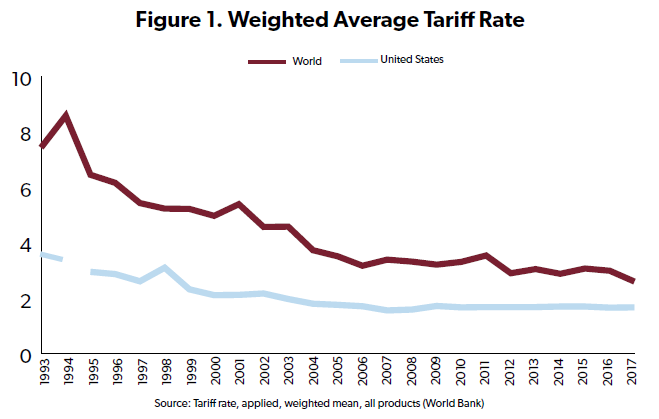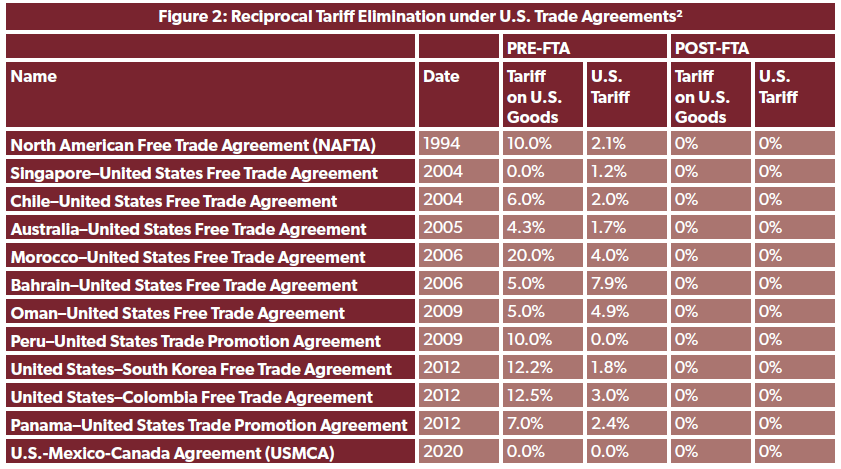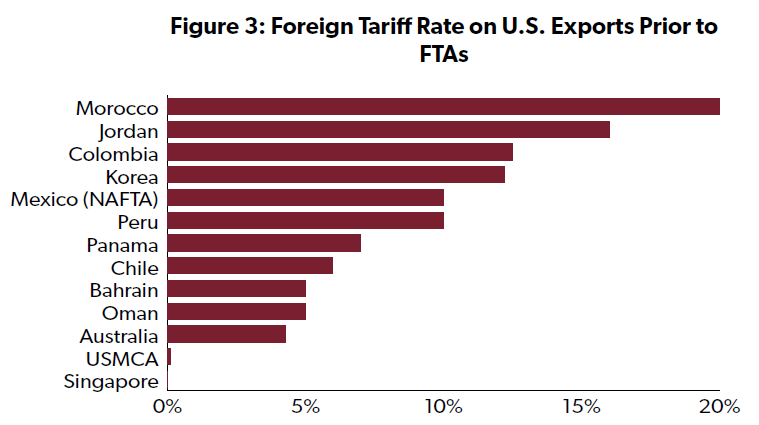(pdf)
President Trump says Americans have been “ripped off” by “disastrous,” “one-sided,” “horror-show” trade deals.[1] The facts suggest otherwise. U.S. trade deals have consistently promoted free, fair, and reciprocal trade, generating unprecedented levels of American prosperity.
U.S. and World Tariff Trends

U.S. policies in recent decades achieved dramatic reductions in foreign taxes on U.S. exports. Since 1993, just before implementation of two historic trade agreements -- the North American Free Trade Agreement (NAFTA) and the Uruguay Round agreement, which created the World Trade Organization (WTO) -- the average world tariff has fallen from 7.4 percent to 2.6 percent, a 4.8 percentage-point reduction. In comparison, the average U.S. tariff rate has declined from 3.8 percent to 1.6 percent.
While average U.S. tariffs remain lower than the world average, the long-term trend before President Trump’s election was toward tariff reciprocity at very low levels.
U.S. Trade Agreements Generate Bigger Foreign Tariff Cuts than U.S. Tariff Cuts
In recent years, Americans have repeatedly been told that the United States has gotten taken advantage of in trade negotiations. By the most straightforward measure, tariff rates, this is inaccurate.
Caroline Freund at the Peterson Institute for International Economics observed, “Trump is right that trade agreements have been one-sided—but he is wrong about the direction. Recent U.S. trade deals, both multilateral and bilateral, have involved much bigger tariff cuts by U.S trading partners than by the United States.”[2]
The United States has negotiated free trade agreements (FTAs) with 21 countries. In all but three of these, foreign tariffs were reduced further than U.S. tariffs.

Additional FTA Tariff Details
The U.S.-Central America-Dominican Republic FTA (CAFTA-DR) reduced foreign tariffs more than U.S. tariffs. Prior to the FTA, the Peterson Institute for International Economics reported: “The U.S. nominal average tariff is much lower than that of any Central American country.”[4] According to the Congressional Research Service, “most U.S. imports from the region had already been duty free.”[5]
Trade agreements with Israel, Canada, and Jordan were not included because bilateral average tariff statistics were unavailable. However, in each case It is likely that FTAs reduced foreign tariffs on U.S. exports more than vice-versa.
Prior to the U.S.-Israel FTA, many imports from Israel arrived tariff-free under the Generalized System of Preferences (GSP) program, while the average tariff imposed on U.S. exports by Israel was 10 percent.[6] In the absence of bilateral weighted average tariff data for the Canada and Jordan FTAs, it is possible to compare the overall average tariff for all imports. When the U.S.-Canada FTA took effect, Canada’s overall average tariff rate for imports from all countries was 7.0 percent, versus a 3.9 percent average tariff in the United States. Just prior to the U.S.-Jordan FTA, the overall average weighted tariff for imports from all countries was 12.3 percent in Jordan, compared to a 2.1 percent U.S. average tariff for all imports. So while more specific bilateral data is not available, other measures strongly suggest that pre-FTA tariffs for Israel, Canada, and Jordan were higher than those imposed by the United States, and like other FTAs they eliminated most tariffs.
Caveats
While it is straightforward to suggest that bigger tariff reductions by our trading partners show that the United States was not taken advantage of, nearly any economist will tell you that U.S. tariff cuts benefit Americans at least as much as foreign tariff cuts. U.S. tariff reductions allow resources to flow to our most competitive industries, give farmers and manufacturers access to the most affordable inputs from across the globe, and indirectly boost U.S. exports.
Also, while every trade agreement is listed as lowering tariff rates to zero, there are almost always special-interest exceptions for politically powerful sectors, so the actual post-FTA tariff is not quite zero. For the vast majority of goods, though, FTAs successfully eliminated nearly all tariffs.

Additional U.S. Benefits from FTAs
Looking only at foreign tariff reductions significantly understates the benefits trade agreements secure for Americans. In addition to eliminating most tariffs, U.S. FTAs have reduced non-tariff trade barriers, discouraged foreign confiscation of Americans’ property, secured better protection of intellectual property rights, removed barriers to international investment, encouraged digital trade, and reduced distortions caused by state-owned enterprises, among other things.[7]
For example, with respect to the U.S.-Singapore FTA, the International Trade Commission (ITC) noted that because the United States had relatively low tariffs, and Singapore had virtually no tariffs, “The FTA’s most important benefits are not related to the reciprocal tariff elimination as much as the agreement’s non-tariff provisions.”[8]
More recently, the USMCA trade deal failed to secure any significant tariff cuts, because, as the ITC observed: “NAFTA has already eliminated duties on most qualifying goods and significantly reduced nontariff measures.”[9] However, USMCA included several significant nontariff provisions. Some of these were beneficial, like rules to encourage digital trade.[10] Others were misguided, like minimum wage mandates and changes to “rules of origin” for automobile production. These provisions for automobile manufacturing will make it more costly to build motor vehicles in North American and increase car prices in the United States.[11] Unlike other U.S. trade agreements, which reduced tariffs, the Congressional Budget Office (CBO) found that USMCA would increase automobile tariff collections by $3 billion over 10 years.[12]
Lessons for the Future
Successful U.S. trade negotiations, combined with foreign countries’ increasing use of unilateral tariff cuts to promote economic growth and prosperity, have significantly reduced foreign barriers to U.S. exports.[13] That trend was interrupted when the Trump administration embarked on a series of unilateral tariff increases that prompted foreign retaliation against U.S.-made exports.
The United States should quit hiking tariffs and starting trade wars. Instead, we should lead by example and eliminate self-destructive trade barriers at home. With respect to trade agreements, the United States should make negotiation of trade deals that lead to zero tariffs, zero nontariff barriers, and zero subsidies its top priority because we know from history that free trade agreements work for America.
Haeseong Shin provided valuable research assistance for this Issue Brief.
Appendix: Sources for Tariff Data
United States-Israel FTA: “Israel Free Trade Agreement,” Office of the U.S. Trade Representative, https://ustr.gov/trade-agreements/free-trade-agreements/israel-fta. “Proposed United States-Israel Free Trade Agreement,” Hearing, U.S. Senate Committee on Finance, March 20, 1985, https://www.finance.senate.gov/imo/media/doc/HRG99-76.pdf.
United States-Canada Free Trade Agreement: U.S. International Trade Commission, dataweb.usitc.gov, and the World Bank, “Tariff rate, applied, weighted mean, all products (%),” https://data.worldbank.org/indicator/TM.TAX.MRCH.WM.AR.ZS.
North American Free Trade Agreement: M. Angeles Villarrael and Ian F. Ferguson, “The North American Free Trade Agreement (NAFTA),” Congressional Research Service, May 24, 2017, https://fas.org/sgp/crs/row/R42965.pdf.
United States-Jordan Free Trade Agreement: The World Bank, “Tariff rate, applied, weighted mean, all products (%),” https://data.worldbank.org/indicator/TM.TAX.MRCH.WM.AR.ZS.
United States-Singapore Free Trade Agreement: “U.S.-Singapore Free Trade Agreement: Potential Economywide and Selected Sectoral Effects,” U.S. International Trade Commission, June 2003, https://www.usitc.gov/publications/332/pub3603.pdf.
United States-Chile Free Trade Agreement: Rodrigo Pizarro, “The Free Trade Agreement between the USA and Chile: An Instrument of U.S. Commercial Interests,” IDEAs Working Paper, February 2006, https://networkideas.org/working/oct2006/02_2006.pdf.
United States-Australia Free Trade Agreement: “U.S.-Australia Free Trade Agreement: Potential Economywide and Selected Sectoral Effects,” U.S. International Trade Commission, May 2004, https://www.usitc.gov/publications/332/pub3697.pdf.
United States-Morocco Free Trade Agreement: Raymond J. Ahearn, “Morocco-U.S. Free Trade Agreement,” Congressional Research Service, February 16, 2006, https://www.everycrsreport.com/files/20060216_RS21464_b992688fa987df0a86525bc41a091b1305f62c56.pdf.
United States-Bahrain Free Trade Agreement: “U.S.-Bahrain Free Trade Agreement: Potential Economywide and Selected Sectoral Effects,” U.S. International Trade Commission, October 2004, https://www.usitc.gov/publications/332/pub3726.pdf; and Office of the U.S. Trade Representative, “Statement of why the United States-Bahrain Free Trade Agreement is in the Interest of U.S. Commerce,” https://ustr.gov/sites/default/files/uploads/Countries%20Regions/africa/agreements/bahrain/Statement%20of%20Why%20the%20U.S.-Bahrain%20FTA%20is%20in%20Interests%20of%20U.S.%20Commerce.pdf. .
Dominican Republic-Central America-United States Free Trade Agreement: J.F. Hornbeck, “The Dominican Republic-Central America United States Free Trade Agreement (CAFTADR): Developments in Trade and Investment,” April 9, 2012, https://fas.org/sgp/crs/row/R42468.pdf and Jose M. Salazar-Xirinachs and Jaime Granados, “The U.S.-Central America Free Trade Agreement: Opportunities and Challenges,” in Free Trade Agreements: U.S. Strategies and Priorities,” ed. Jeffrey J. Schott, Peterson Institute for International Economics, April 2004, https://www.piie.com/publications/chapters_preview/375/09iie3616.pdf.
United States-Oman Free Trade Agreement: “U.S.-Oman Free Trade Agreement: Potential Economy-wide and Selected Sectoral Effects,” U.S. International Trade Commission, February 2006, and data from U.S. International Trade Commission, dataweb.usitc.gov.
United States-Peru Trade Promotion Agreement: M. Angeles Villarreal “U.S.-Peru Economic Relations and the U.S.-Peru Trade Promotion Agreement,” Congressional Research Service, July 27, 2007, https://fas.org/sgp/crs/row/RL34108.pdf.
United States-Korea Free Trade Agreement: “U.S.-Korea Free Trade Agreement: Potential Economy-wide and Selected Sectoral Effects,” U.S. International Trade Commission, September 2007, https://www.usitc.gov/publications/pub3949.pdf, “The Importance of the U.S.-Korea Free Trade Agreement to U.S. Economic Growth and Job Creation,” Business Roundtable, https://www.businessroundtable.org/archive/resources/the-importance-of-the-u.s.-korea-free-trade-agreement-to-u.s.-economic-grow, and Yeongkwan Song, “KORUS FTA vs. Korea-EU FTA: Why the Differences?” Korea Economic Institute, May 2011, https://keia.org/sites/default/files/publications/song_final_paper.pdf.
United States-Colombia Free Trade Agreement: “The U.S.-Colombia Free Trade Agreement:
Background and Issues,” Congressional Research Service, March 28, 2018, https://www.everycrsreport.com/files/20180328_RL34470_91952433e4580622bd0b7d6b27796e5c4dc1e761.pdf.
United States-Panama Trade Promotion Agreement: “U.S.-Panama Free Trade Agreement,” U.S. Chamber of Commerce, https://www.uschamber.com/international/americas/us-panama-free-trade-agreement, and data from U.S. International Trade Commission, dataweb.usitc.gov.
Uruguay Round Trade Agreement: The World Bank, “Tariff rate, applied, weighted mean, all products (%),” https://data.worldbank.org/indicator/TM.TAX.MRCH.WM.AR.ZS.
[1] President Donald J. Trump, Twitter. August 11, 2019,; ibid, September 30, 2020; ibid, March 27, 2016; ibid, August 3, 2019.
[2] Freund, Caroline. “The United States Wins from Trade Agreements.” Peterson Institute for International Economics, December 18, 2017. Retrieved from https://www.piie.com/blogs/trade-and-investment-policy-watch/united-states-wins-trade-agreements.
[3] Data from the Office of the U.S. Trade Representative, the U.S. International Trade Commission, the U.S. Chamber of Commerce, the Peterson Institute for International Economics, and the World Bank.
[4] Salazar-Xirinachs, Jose M., and Granados, Jaime. “The U.S.-Central American Free Trade Agreement: Opportunities and Challenges,” in Free Trade Agreements: U.S. Strategies and Priorities, Jeffrey J. Schott, ed., Peterson Institute for International Economics, April 2004. Retrieved from https://www.piie.com/publications/chapters_preview/375/09iie3616.pdf.
[5] “Dominican Republic-Central America-United States Free Trade
Agreement (CAFTA-DR),” Congressional Research Service, Updated August 22, 2019. Retrieved from: https://fas.org/sgp/crs/row/IF10394.pdf.
[6] U.S. Cong. Senate Committee on Finance. "Hearing: Proposed United States-Israel Free Trade Agreement," March 20, 1985. 99th Congress, First Session. (Testimony of Thomas A. Dine, Executive Director, American Israel Public Affairs Committee.) Retrieved from https://www.finance.senate.gov/imo/media/doc/HRG99-76.pdf.
[7] Public Law 114-26, “Bipartisan Congressional Trade Priorities and Accountability Act of 2015.” Retrieved from
https://www.congress.gov/114/plaws/publ26/PLAW-114publ26.pdf.
[8] “U.S.-Singapore Free Trade Agreement: Potential Economywide and Selected Sectoral Effects,” U.S. International Trade Commission, June 2003. Retrieved from https://www.usitc.gov/publications/332/pub3603.pdf.
[9] United States International Trade Commission. (2019.) “U.S.-Mexico-Canada Trade Agreement: Likely Impact on the U.S. Economy and on Specific Industry Sectors.” April 2019. Retrieved from
[10] USMCA Digital Trade Fact Sheet, Office of the U.S. Trade Representative, https://ustr.gov/sites/default/files/files/Press/fs/USMCA/USMCA-Digital_Trade.pdf.
[11] United States International Trade Commission. (2019.) “U.S.-Mexico-Canada Trade Agreement: Likely Impact on the U.S. Economy and on Specific Industry Sectors.” April 2019. Retrieved from
[12] M. Angeles Villarreal, M. Angeles and Ferguson, Ian F. “The United States-Mexico-Canada Agreement (USMCA).” Congressional Research Service, Updated July 27, 2020. Retrieved from https://crsreports.congress.gov/product/pdf/R/R44981.
[13] Riley, Bryan. “Tariff Reform Needed to Boost the U.S. Economy,” The Heritage Foundation, April 29, 2013. Retrieved from https://www.heritage.org/node/11842/print-display.

